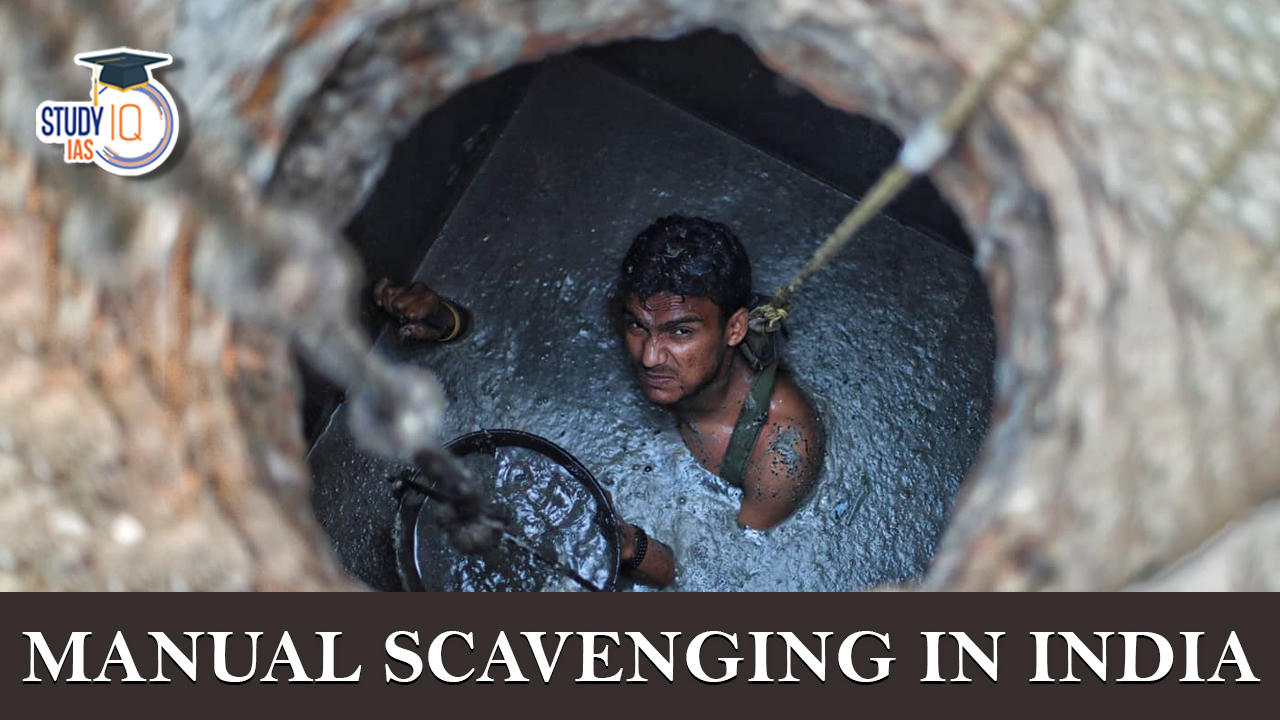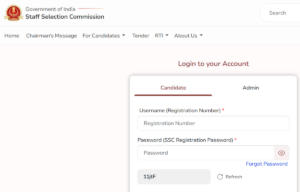Table of Contents
Context: Over the past five years, there have been 339 deaths reported during sewer and septic tank cleaning activities, despite the ban on manual scavenging, as stated by the Minister of State for Social Justice and Empowerment.
What is Manual Scavenging?
- Manual scavenging is a dehumanizing practice that involves the manual cleaning and handling of human excreta from dry latrines, sewers, septic tanks, railway lines, and other such places, typically using basic tools like brooms.
- It is predominantly a caste-based and forced occupation in India.
- The eradication of manual scavenging is of utmost importance for achieving various Sustainable Development Goals (SDGs).
- Manual scavenging undermines SDGs related to clean water and sanitation (Goal 6), decent work and economic growth (Goal 8), reduced inequalities (Goal 10), and peace, justice and strong institutions (Goal 10).
- This practice not only violates various international conventions but also contradicts India’s legislative and constitutional mandates.

Prevalence of Manual Scavenging in India
- Currently, there are approximately 58,098 individuals identified as “eligible manual scavengers” across the country, according to the survey by the Social Justice and Empowerment Ministry.
- More than 55% of the 58,098 manual scavengers identified were from Uttar Pradesh.
- Of the 58,098 manual scavengers identified, more than 40,000 workers belong to the Scheduled Castes, while fewer than 1,000 belong to the Scheduled Tribes and OBCs combined.
Factors Responsible for the Persistence of Manual Scavenging in India
- Informal Economy and Lack of Recognition: The practice of manual scavenging often occurs within the informal economy, making it challenging to identify and provide associated rights and protections to those involved.
- Continuance of Unsanitary Latrines: Many parts of India still have unsanitary dry latrines that require manual cleaning. Lack of modern, hygienic toilet facilities leads to continued reliance on manual scavenging for waste disposal.
- Increasing Urbanization: Urbanization has led to the construction of toilets under initiatives like ‘Swachh Bharat Mission,’ but many of these toilets require manual cleaning due to poor planning and lack of long-term waste disposal solutions.
- Weak Legal Framework: The Manual Scavenging (Prohibition) Act of 2013 does not consider the cleaning of human excreta with protective gear as manual scavenging, creating loopholes in the law and failing to address the issue comprehensively.
- Ineffective Implementation: Despite the ban on manual scavenging since 1993, the practice persists due to inadequate enforcement and implementation of the laws and regulations.
- Social Deprivation: Manual scavengers, often from certain marginalized castes, have faced social stigma for generations. Despite welfare measures and laws, they have been shunned and despised, leading to limited opportunities for them to escape this occupation.
- Water Scarcity and Sanitation Issues: In certain rural areas of India, inadequate access to proper water supply results in the manual removal of excreta from toilets, as alternative sanitation facilities are lacking.
- Challenges in Restoration and Rehabilitation: The complex procedures for procuring loans through different schemes, such as the National Safai Karamcharis Finance and Development Corporation (NSKFDC), create barriers for manual scavengers to access funds for restoration and rehabilitation.
- Lack of Organized Representation: Manual scavengers often lack organized representation, such as trade unions or advocacy groups, which could amplify their voices and protect their rights. They belong to highly marginalized sections of society, perpetuating their exploitation.
- Absence of Mechanization: The design of septic tanks often requires manual cleaning, as they are not equipped with mechanisms for safe and automated disposal of waste, further perpetuating the need for manual scavenging.
Initiatives taken to prevent Manual Scavenging
The Government of India has undertaken several initiatives to address the issue of manual scavenging and improve the lives of those involved.
- National Action for Mechanized Sanitation Ecosystem (NAMASTE): It is a Central Sector Scheme, launched to promote 100% mechanization, specially cleaning of sewers, septic tanks, desilting of drains, garbage lifting, sludge handling, solid and medical waste disposal etc.
- The Prohibition of Employment as Manual Scavengers and their Rehabilitation Act, 2013: This Act supersedes the 1993 Act and prohibits all forms of manual excrement cleaning of insanitary latrines, open drains, or pits.
- It also focuses on the rehabilitation of manual scavengers and provides measures for their welfare.
- The Prohibition of Employment as Manual Scavengers and their Rehabilitation (Amendment) Bill, 2020: This proposed amendment aims to mechanize sewer cleaning, introduce on-site protection for workers, and provide compensation to manual scavengers in case of sewer-related deaths. However, it is still awaiting cabinet approval.
- The Building and Maintenance of Insanitary Latrines Act, 2013: This Act prohibits the construction or maintenance of unsanitary toilets and the hiring of individuals for manual scavenging.
- It also places a constitutional responsibility on the government to provide alternative jobs and assistance to manual scavenging communities as reparation for historical injustice and indignity.
- Changed terminologies: Prohibiting use of the word ‘manhole’ anymore and instead using only ‘machine-hole’ to support the government’s decision to eradicate manual scavenging.
- Safai-mitra Suraksha Challenge across 243 cities: It aims to ensure that no life is ever lost while cleaning sewer or septic tanks.
- Under the campaign, sewers and septic tanks in 243 cities will be mechanized and a helpline created to register complaints if manual scavenging is reported. Cities which reach the end result will receive prize money.
- Swachhta Abhiyan App: Developed to identify and geotag insanitary latrines and manual scavengers, this app helps in replacing insanitary latrines with sanitary latrines and facilitating the rehabilitation of manual scavengers, thereby promoting a life of dignity for them.
- Safai Karamchari vs Union of India, 2014: The Supreme Court has ruled that the continuance of manual scavenging in the country is in blatant violation of Article 17 of the Constitution of India by which, “untouchability is abolished and its practice in any form is forbidden”.
- The court was emphatic about the duty cast on all states and union territories “to fully implement the law and to take action against the violators”.
Way forward
Eliminating the demand:
- Promoting scientific waste disposal and raising awareness to prevent the clogging of sewer lines.
- Replicating successful models like the Kerala model, which employs technology-driven solutions for manhole cleaning.
- Encouraging behavioural change through information, education, and communication campaigns, along with effective implementation of laws.
- Ensuring access to Water, Sanitation, and Hygiene (WASH) facilities to facilitate behavioural changes.
Eliminating the supply:
- Ensuring proper identification of manual scavengers through accurate data collection and surveys.
- Recognizing and prioritizing the needs of women engaged in manual scavenging and empowering them.
- Facilitating easy access to rehabilitation measures, including loans and skill development programs, and providing legal support in case of violations of the law.
- Mobilizing manual scavengers into trade unions, self-help groups, cooperatives, and pressure groups to protect their interests and give them a voice.
- Inclusive policy-making by actively involving manual scavengers as stakeholders to identify loopholes in the system and shape effective policies.


 Indian Sex Ratio 2024, NFHS-5 Survey Est...
Indian Sex Ratio 2024, NFHS-5 Survey Est...
 Kargil Vijay Diwas 2024, Date, History a...
Kargil Vijay Diwas 2024, Date, History a...
 SSC CGL Apply Online 2024, Last Date is ...
SSC CGL Apply Online 2024, Last Date is ...

















